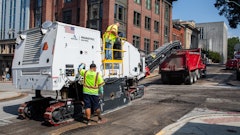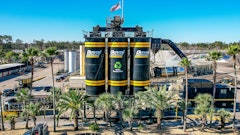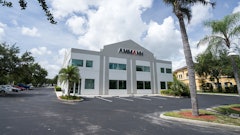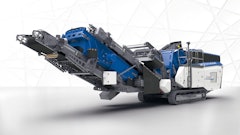
The slowing U. S. economy is having a significant impact on the asphalt industry. The reality of today’s ever-climbing fuel and liquid asphalt (AC) prices combined with shrinking state Department of Transportation budgets is resulting in fewer let projects, increased competition and asphalt producers looking for ways to be more efficient.
“When I first started in this business in 1974, AC was $28 per ton, and we were laying mix for about $10 per ton,” recalls Murrel Wisdom, general manager for Mountain Enterprises, a subsidiary of Oldcastle Materials, Inc. “Today, liquid asphalt is $700 per ton and mix is about $70 to $80 per ton.”
With its headquarters in Lexington, Mountain Enterprises has been a fixture in Eastern Kentucky for 32 years, and Wisdom has been with Mountain from the beginning. Today, he has managerial responsibility over 10 asphalt plants throughout the company’s Eastern Kentucky market. Five of those are batch plants, while the other five are counterflow drum mix plants. A common link for all of the plants is their heritage, in which all have Terex legacy brand — CMI, Cedarapids and Standard Havens — components.
The producer is undergoing a measured transition of switching all of their plants to counterflow drum mix designs. Its latest conversion and shift to increase efficiency included moving a 1990 Cedarapids counterflow drum, cold feed bins and conveyors from Paintsville to Hazard, KY, to replace a 1970s-vintage Cedarapids batch plant. “The old plant in Hazard was basically worn out, and we are able to cover the Paintsville market with a nearby asphalt plant,” explains Wisdom.
Supplying mix to its internal paving crews and public and private sector customers, Mountain Enterprises needs an efficient plant in Hazard to quickly make a variety of mix designs. Some of the most popular mixes are a 38D, 3/8 inch surface; 75D, ¾ inch base; and 1.5-inch number 4 base products. Whenever possible, the producer tries to run RAP in its designs. “Depending on the product, we’ll run between 10 to 20 percent RAP in mixes for both our public and private customers,” says Bob Graves, area manager for Mountain Enterprises.
Ingenious solution
While the Hazard plant needed to be upgraded, the slow Kentucky asphalt market meant that Wisdom had to be judicious in the selection of a new plant. The Paintsville counterflow drum mixer had produced about 400,000 tons of mix over its life, so Wisdom saw this as an opportunity to save some money on a new plant purchase. “If properly cared for, a Terex drum mixer can produce from 2 to 3 million tons of asphalt over its lifetime,” mentions Steve O’Neal, district manager, asphalt plants for Terex Roadbuilding. “By not replacing the drum, we saved about $500, 000,” adds Wisdom.
While being more than 25 years old, the drum includes virtually the same, proven inside-the-drum counterflow technology as today’s mixers, allowing it to operate with lower emissions than parallel flow drums. “The drum has the patented adjustable slinger, which allows a staged mixing that provides infinite control of exhaust gas temperatures,” mentions O’Neal.
In addition to salvaging and moving the drum mixer, Mountain Enterprises also moved its four cold feed bin system from Paintsville to Hazard. This saved Mountain about another $200,000 off the price of a complete stationary plant. A fifth bin was added to the system for more efficient aggregate utilization when the producer mixes department of transportation designs.
With the bins and drum serving as the anchors of the new plant, the producer added two Terex 200-ton silos, to help improve plant efficiency. “With the two silos, our truck cycle times are nearly twice as fast as they were with our old batch plant,” points out Graves. The Magnum silos are equipped with heavy-duty leg frames and support structures, and 6-inch side and 12-inch top insulation to help increase storage time of the mixes. Silo discharge includes the latest safety gate technology and a 55 degree cone to reduce material segregation.
For emissions control, Mountain Enterprises added a Terex® RA320S Roto-Aire baghouse. Two 125-hp. motors powering a 542 fan generates 68,000-cfm air flow, while 16,992 square feet of cloth offers a low 4.1-to-1 air-to-cloth ratio for efficient particulate capture. The baghouse does not rely on air compressors, so there are fewer moving parts to minimize maintenance.
Rounding out the new components purchased for the Hazard plant are two 30,000-gallon vertical AC tanks to reduce the plant’s footprint, an upgrade to the most recent Terex plant controls package and a complete RAP run-around system. A closed-loop crushing circuit that allows oversized material not passing the screen deck to be properly resized, the RAP crushing system is a critical component that allows Mountain Enterprises to control mix costs. “Running 10 percent RAP saves us approximately 1.5 percent liquid asphalt per ton in a mix calling for 5.5 percent AC,” explains Graves.
By melding the existing components with the new, some would be concerned about how well all the components would work together. However, according to Graves that has not been a problem. “All the plant components are working well together, and it’s a great plant for making mix,” he says. In addition to its staple mixes, Mountain Enterprises is also mixing polymer-modified designs with the plant.
A tight fit
Prior to the new and existing plant components coming together in Hazard, the only real concern that Graves and Wisdom had was how to fit everything on the small site. That’s where Terex Roadbuilding stepped in to provide assistance.
“It really was not the size of the Hazard location but its shape and elevation,” explains Tim Franck, design engineer for Terex Roadbuilding. “We also had to design the new plant around the existing batch plant, so it was definitely a challenge for us.” The perimeter of the site was surrounded by three major obstacles — the four-lane State Highway 15, a service road and a right-of-way restriction. This created a triangular footprint for the plant.
According to Franck, it was a team effort to get the plant layout to fit the lot size so material would flow freely and the design would leave access for future plant maintenance. After laying out the initial design electronically, Franck and O’Neal took the plans to Hazard. “The four of us (Franck, O’Neal, Wisdom and Graves) went to the site and used spray paint to map out the location of all the components,” says Franck. “We had to make several runs at it before we could make it work.”
The major challenge to getting the layout right revolved around the silos and RAP run-around system. Wisdom wanted the trucks to enter and exit Highway 15 from a traffic light at the south end of the lot. However, this limited silo position options, and the final site selection required some creative engineering. “Typically, the bottom of the silos and slat conveyors are on the same level, but with this installation the silos had to be positioned about 2 ft. below the drag slat, which required us to shorten the slat,” explains Franck.
While it was critical to install the RAP run-around system, the crushing circuit’s footprint posed a problem with the extremely tight plant site. Franck was forced to elevate the crusher and shorten the conveyor from the RAP bin to the screen in order to leave access for maintenance. “It’s remarkable that they were able to fit everything on this site,” marvels Graves.
With installation complete and initial reports positive, the last hurdle for Mountain Enterprises was the stack tests. Again, the plant impressed both Wisdom and Graves. “The EPA (Environmental Protection Agency) representatives were amazed at how clean the plant runs, and even I cannot tell if the plant is operating just by looking at it,” says Wisdom.
For the EPA Opacity or Method 5 (visual) inspection, which allows up to 20 percent opacity, the Hazard asphalt plant passed with a perfect score of zero. A total of three emissions tests were run on the new plant setup, and the baghouse stack test averaged 0.019, less than half of the federal 0.04 maximum allowable.



























